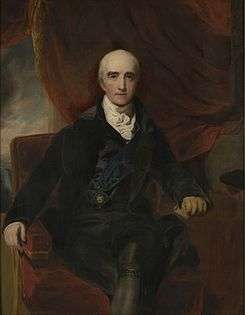Mahalwari
The Mahalwari (Hindi: महलवारी) was a revenue collection system that was introduced by Holt Mackenzie in British India.It was one of the three major land tenure systems implemented by the British in India. The other two systems were the Permanent Settlement of Bengal and the Ryotwari system. During the 1800s, the British tried to establish their control over the administrative machinery of India. The System of Land Revenue acted as a chief source of income of the British. Land was one of the most important source of income for the British. Thus, they used land to control the entire Revenue system, strengthening their economic condition in India.
The word Mahalwari (महलवारी) is derived from the Hindi word Mahal (महल), which means house, district, neighbourhood or quarter.[1] This system consisted of landlords or Zamindars claiming to represent entire villages or even groups of villages. Along with the village communities, the landlords were jointly responsible for the payment of the revenues. But, individual responsibility was always there. The land included under this system consisted of all land of the villages, even the forestland, pastures etc.
This system was prevalent in the parts of Uttar Pradesh, the North Western province, parts of Central India and Punjab[2]
Origin of the Mahalwari System
The north-western states and Awadh (also known as Oudh) were two important territories acquired by the British in India. In 1801, the Nawab of Awadh surrendered the districts of Allahabad to the British. The Jamuna and the Ganges came to the British after the Second Anglo-Maratha War. Lord Hastings (has nothing to do with Warren Hastings) conquered more territories of North India after the Third Anglo-Maratha War in the year 1820.

Lord Wellesley made a land revenue system with the Zamindars that existed 3 years. In this system, state demand was fixed higher by two million rupees during the very first year.[3] That was much more than the Nawabs demand. A further burden of a million rupees was implemented by the third year.
The village headman or Lambardar was completely responsible for all the recommendations, the survey of lands, preparation of the records of rights in lands, settlement of the land revenues, demand in the Mahals, and the collection of the land revenue. The Regulation VII of 1822 accredited the legal sanction to these recommendations. In cases where estates were not held by the landlords, but by the cultivators in common tenancy, the state demand was allowed to be fixed at 95% of the rental. However, quite unfortunately, this system broke down as the state demand was excessively large and its working was quite rigid. The amount, payable by the cultivators was quite more than what they could afford.[4]
Development of Mahalwari System

The government of William Bentinck made a thorough revision of the act of 1822, and thus the Mahalwari System was introduced. They realized that the result of the Regulation of 1822 was nothing other than widespread misery.
After a prolonged consultation, the Government finally passed a new regulation in 1833. This played a huge part in making the system more flexible. The process of preparing estimates of produce and rents was simplified too. It also introduced the fixation of the average rents for different classes of soil. This scheme functioned under Mettins Bird. The processes of measuring land, examining soil quality was improved further. The State demand was fixed at 66% of the rental value and the Settlement was made for 30 years.
The Mahalwari system of land revenue worked under the scheme of 1833 was completed under the administration of James Thompson. The 66% rental demanded proved very harsh, too. In the Saharanpur Rules of 1855, it was revised to 50% by Lord Dalhousie. However, the British officers hardly cared of these rules. This created widespread discontent among the Indians.[5]
"Mahalwari System of land revenue was introduced by Holt MacKenzie and Robert Marttins Bird"
See also
References
- ↑ "Mahalwari system". Encyclopædia Britannica.
- ↑ Chapter 4: Getting Ahead in Social Science with CCE 8 published by Orient Blackswan.
- ↑ http://www.iosrjournals.org/iosr-jhss/papers/Vol2-issue4/D0241626.pdf2013
- ↑ http://www.preservearticles.com/2011090412831/brief-notes-on-the-mahalwari-system-in-india-1757-1857.html
- ↑ Cohn, Bernard S. (August 1960). "The Initial British Impact on India: A case study of the Benares region". The Journal of Asian Studies. Association for Asian Studies. 19 (4): 418–431. doi:10.2307/2943581. JSTOR 2943581.
Further reading
- The History of India, vol.2, T.G.Percival Spear, Penguin (1990) ISBN 0-14-013836-6
- India: A History, John Keay, Grove/Atlantic (2001) ISBN 0-8021-3797-0
- A rule of property for Bengal: an essay on the idea of permanent settlement, Ranajit Guha, Durham, Duke U Press (1996) ISBN 0-8223-1771-0